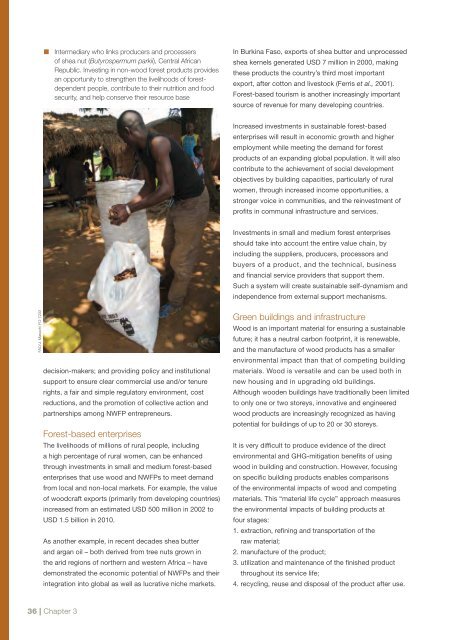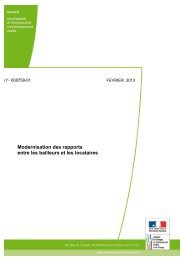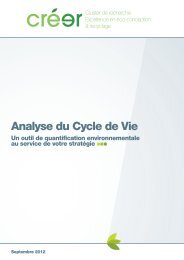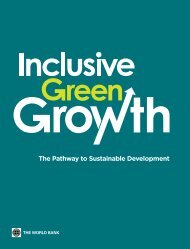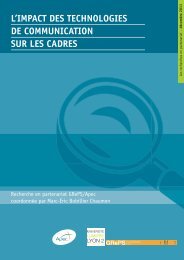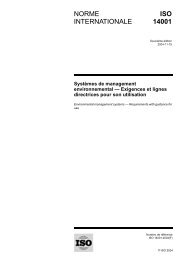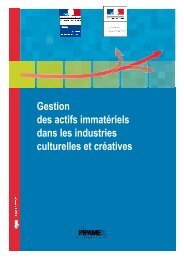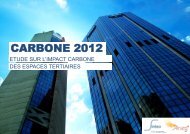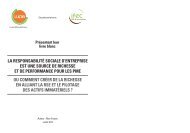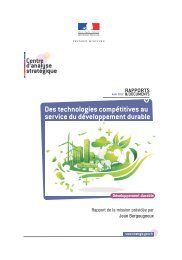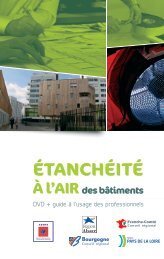■■Intermediary who links producers and processers<strong>of</strong> shea nut (Butyrospermum parkii), Central AfricanRepublic. Investing in non-wood forest products providesan opportunity to streng<strong>the</strong>n <strong>the</strong> livelihoods <strong>of</strong> forestdependentpeople, contribute to <strong>the</strong>ir nutrition and foodsecurity, and help conserve <strong>the</strong>ir resource baseIn Burkina Faso, exports <strong>of</strong> shea butter and unprocessedshea kernels generated USD 7 million in 2000, making<strong>the</strong>se products <strong>the</strong> country’s third most importantexport, after cotton and livestock (Ferris et al., 2001).Forest-based tourism is ano<strong>the</strong>r increasingly importantsource <strong>of</strong> revenue for many developing countries.Increased investments in sustainable forest-basedenterprises will result in economic growth and higheremployment while meeting <strong>the</strong> demand for forestproducts <strong>of</strong> an expanding global population. It will alsocontribute to <strong>the</strong> achievement <strong>of</strong> social developmentobjectives by building capacities, particularly <strong>of</strong> ruralwomen, through increased income opportunities, astronger voice in communities, and <strong>the</strong> reinvestment <strong>of</strong>pr<strong>of</strong>its in communal infrastructure and services.Investments in small and medium forest enterprisesshould take into account <strong>the</strong> entire value chain, byincluding <strong>the</strong> suppliers, producers, processors andbuyers <strong>of</strong> a product, and <strong>the</strong> technical, businessand financial service providers that support <strong>the</strong>m.Such a system will create sustainable self-dynamism andindependence from external support mechanisms.FAO/J. Masuch/ FO-7233decision-makers; and providing policy and institutionalsupport to ensure clear commercial use and/or tenurerights, a fair and simple regulatory environment, costreductions, and <strong>the</strong> promotion <strong>of</strong> collective action andpartnerships among NWFP entrepreneurs.Forest-based enterprisesThe livelihoods <strong>of</strong> millions <strong>of</strong> rural people, includinga high percentage <strong>of</strong> rural women, can be enhancedthrough investments in small and medium forest-basedenterprises that use wood and NWFPs to meet demandfrom local and non-local markets. For example, <strong>the</strong> value<strong>of</strong> woodcraft exports (primarily from developing countries)increased from an estimated USD 500 million in 2002 toUSD 1.5 billion in 2010.As ano<strong>the</strong>r example, in recent decades shea butterand argan oil – both derived from tree nuts grown in<strong>the</strong> arid regions <strong>of</strong> nor<strong>the</strong>rn and western Africa – havedemonstrated <strong>the</strong> economic potential <strong>of</strong> NWFPs and <strong>the</strong>irintegration into global as well as lucrative niche markets.Green buildings and infrastructureWood is an important material for ensuring a sustainablefuture; it has a neutral carbon footprint, it is renewable,and <strong>the</strong> manufacture <strong>of</strong> wood products has a smallerenvironmental impact than that <strong>of</strong> competing buildingmaterials. Wood is versatile and can be used both innew housing and in upgrading old buildings.Although wooden buildings have traditionally been limitedto only one or two storeys, innovative and engineeredwood products are increasingly recognized as havingpotential for buildings <strong>of</strong> up to 20 or 30 storeys.It is very difficult to produce evidence <strong>of</strong> <strong>the</strong> directenvironmental and GHG-mitigation benefits <strong>of</strong> usingwood in building and construction. However, focusingon specific building products enables comparisons<strong>of</strong> <strong>the</strong> environmental impacts <strong>of</strong> wood and competingmaterials. This “material life cycle” approach measures<strong>the</strong> environmental impacts <strong>of</strong> building products atfour stages:1. extraction, refining and transportation <strong>of</strong> <strong>the</strong>raw material;2. manufacture <strong>of</strong> <strong>the</strong> product;3. utilization and maintenance <strong>of</strong> <strong>the</strong> finished productthroughout its service life;4. recycling, reuse and disposal <strong>of</strong> <strong>the</strong> product after use.36 | Chapter 3
J. PereUsing broad-scale indicators and <strong>the</strong> life cycleassessment approach, a comparison <strong>of</strong> wood and o<strong>the</strong>rconstruction materials can be summarizedas follows:• Global warming potential, measured in CO 2emissions:Wood is CO 2-neutral and has a negative globalwarming effect – wood products provide net storage,ra<strong>the</strong>r than release, <strong>of</strong> CO 2. The precise score dependson <strong>the</strong> boundaries <strong>of</strong> life cycle analysis, but woodeasily outperforms concrete, brick, stone and metal,all <strong>of</strong> which are sourced from extractive industries andrequire intensive energy use throughout <strong>the</strong>ir miningand processing chains.• Photochemical ozone creation potential (ethaneemissions): Wood products emit far less ethane thanaluminium, and significantly outperform PVC plastics.• Acidification potential (sulphur dioxide emissions):The sulphur dioxide emissions associated with woodproducts are only 40 to 50 percent as large as thoseassociated with aluminium and PVC.• Eutrophication potential (enrichment <strong>of</strong> dissolvedphosphate): Wood products are associated withapproximately two-thirds <strong>of</strong> <strong>the</strong> eutrophication potentialassociated with aluminium and PVC.Globally, existing buildings account for more than40 percent <strong>of</strong> total primary energy consumption and24 percent <strong>of</strong> CO 2emissions (IEA, 2006). The rapidlyexpanding construction sector that is needed to meet<strong>the</strong> needs <strong>of</strong> an ever-increasing population is likelyto exacerbate this energy and climate impact.Energy savings from buildings that are resource- andenergy-efficient throughout <strong>the</strong>ir life cycles will <strong>the</strong>refore■■Kooraste hunting house, sou<strong>the</strong>ast Estonia. Althoughwooden buildings have traditionally been limited to onlyone or two storeys, innovative and engineered woodproducts are increasingly recognized as having potentialfor buildings <strong>of</strong> up to 20 or 30 storeysbe critically important. This situation presents anopportunity for increasing <strong>the</strong> use <strong>of</strong> wood products:wood’s lower carbon footprint makes it a rational andnatural choice for a greener building sector.Strategies for <strong>the</strong> futureStrategies for realizing forests’ potential contribution toa sustainable future include improving <strong>the</strong> quality andquantity <strong>of</strong> forests by planting trees and investing inecosystem services, promoting small and medium forestbasedenterprises to reduce rural poverty and improveequity, increasing <strong>the</strong> long-term value <strong>of</strong> wood productsby reusing and recycling <strong>the</strong>m and using wood for energy,and enhancing communication and linkages across <strong>the</strong>physical and institutional landscape.Planting trees and investing inecosystem servicesPlanting trees is <strong>of</strong>ten <strong>the</strong> quickest and most effectiveway <strong>of</strong> producing new biomass, thus helping to <strong>of</strong>fset<strong>the</strong> loss <strong>of</strong> carbon resulting from deforestationor forest degradation on ano<strong>the</strong>r plot <strong>of</strong> land.Investing in new carbon stocks has great potentialto make a significant, fast and measurable impacton climate change without requiring sweepingchanges in policies, cultures or national economies.Several developing countries, notably in Asia, havedemonstrated that major investments in planted forestscan reverse <strong>the</strong> trend towards deforestation and result ina net increase in forest area.The UNEP report Towards a green economy: pathwaysto sustainable development and poverty eradication(<strong>the</strong> Green Economy Report; UNEP, 2011) calls forinvestments in reforestation <strong>of</strong> USD 22 billion per annumover <strong>the</strong> next 40 years. This level <strong>of</strong> reforestation wouldcertainly increase <strong>the</strong> sequestration <strong>of</strong> carbon in woodybiomass, and may be large enough to have an impact onclimate change. However, considerable hurdles wouldneed to be overcome: it is not clear where <strong>the</strong> fundswould originate, where <strong>the</strong> trees would be planted, orhow a global programme <strong>of</strong> this magnitude would beadministered. Planted forests must be designed for localconditions; <strong>the</strong> trees must be appropriate, ideally nativespecies; and planting programmes must take localcultures and economic conditions into account.Planted forests are not a simple one-time investment;<strong>the</strong>y must be properly nourished and managed to ensure<strong>the</strong>ir long-term success. Never<strong>the</strong>less, <strong>the</strong> planting <strong>of</strong>new forests on a massive scale could result in zero netdeforestation on <strong>the</strong> global scale, with or without REDD.<strong>Forests</strong>, forestry and forest products for a sustainable future | 37


